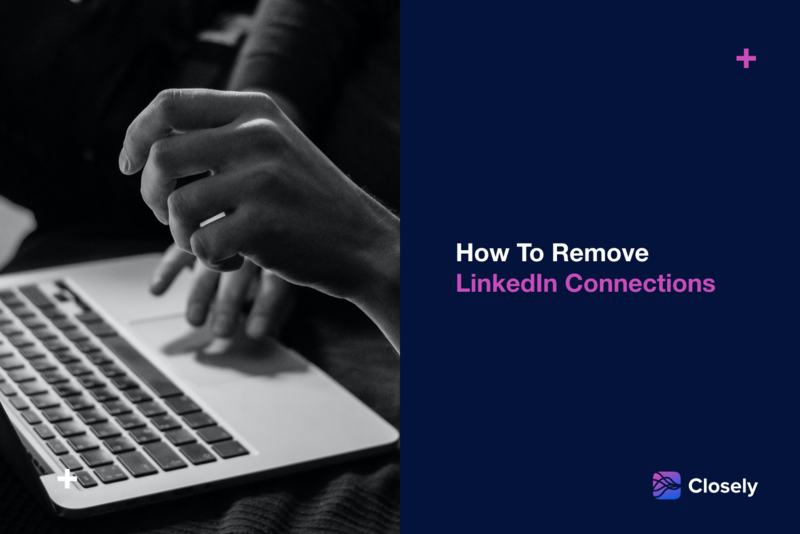Networking is essential in today's digital age, and LinkedIn is the go-to platform for professionals. However, as you build your network, you might find that not all connections serve your goals. This post will guide you on how to delete connections on LinkedIn to keep your network clean and relevant. Let’s dive into the importance of understanding your connections!
Understanding LinkedIn Connections

LinkedIn connections are more than just a list of names; they represent your professional relationships and opportunities. Here’s why it’s crucial to understand them:
- Quality Over Quantity: Having a large number of connections might seem impressive, but it's the quality that truly matters. Thoughtful connections can open doors to new opportunities, while irrelevant ones can clutter your profile.
- Networking Efficiency: By managing your connections, you’re ensuring that your networking efforts are focused on individuals who align with your career goals. This makes it easier to engage meaningfully and build stronger relationships.
- Professional Reputation: A well-curated network reflects professionalism. When potential employers or collaborators view your profile, they'll see a network that aligns with your expertise and ambitions.
To get a clearer picture of your connections, consider the following:
| Type of Connection | Considerations |
|---|---|
| Colleagues | Great for job opportunities and referrals. |
| Industry Peers | Valuable for insights and trends in your field. |
| Former Classmates | Can lead to unexpected collaborations. |
| Random Connections | Assess if they genuinely add value to your network. |
As you evaluate your connections, think about how they contribute to your personal and professional development. Are they providing insights, opportunities, or merely occupying space? Understanding these dynamics will empower you to make informed decisions about who to keep or remove from your LinkedIn network.
Also Read This: How to Clear LinkedIn Search History
3. Reasons to Delete a Connection
Networking on LinkedIn is all about quality over quantity. While it might be tempting to connect with everyone and anyone, sometimes it’s essential to prune your connections for a more effective network. Here are some compelling reasons why you might consider deleting a connection:
- Irrelevant Connections: If a connection doesn't align with your professional interests or industry, they might not provide value to your network. For instance, if you work in tech but have connections primarily from the fashion industry, it may be time to reassess those ties.
- Inactive Profiles: It’s frustrating to see connections who haven’t engaged on LinkedIn in ages. If someone hasn’t updated their profile or posted in years, their absence might indicate a lack of relevance in your network.
- Negative Influence: Sometimes, connections can actually hinder your professional growth. If you encounter individuals who consistently post negativity or contentious content, removing them can help create a more positive feed.
- Unprofessional Behavior: If a connection has acted unprofessionally—perhaps through inappropriate messages or offensive comments—it's perfectly okay to distance yourself. You want your network to reflect your values.
- Changing Goals: As your career evolves, so should your network. If your goals have shifted and certain connections no longer add value to your career trajectory, it's wise to make those cuts.
Ultimately, maintaining a focused and relevant network can foster better opportunities and meaningful connections that align with your professional aspirations. Remember, it’s not about the number of connections, but the quality and relevance of each relationship!
Also Read This: Making Effective Introductions on LinkedIn to Build Strong Networks
4. Step-by-Step Guide to Deleting a Connection
Deleting a connection on LinkedIn is a straightforward process. Let’s walk through each step to make sure you feel confident doing it yourself.
- Log in to Your LinkedIn Account: Start by signing into your LinkedIn profile. Make sure you're on your homepage.
- Go to My Network: Click on the “My Network” icon at the top of your LinkedIn homepage. This will take you to a page where you can see all your connections.
- Find the Connection: Scroll through your list or use the search bar to find the connection you want to delete. You can type their name into the search bar for quicker access.
- Click on the Connection’s Profile: Once you find the person, click on their name to view their profile. This gives you a chance to review their activity one last time before taking action.
- Remove Connection: On their profile page, look for the “More” button (often represented by three dots). Click on it, and a dropdown menu will appear. Select “Remove Connection.”
- Confirm the Deletion: A prompt will ask you to confirm that you really want to remove this connection. Take a moment to ensure this is your decision, then click “Remove.”
And just like that, you’ve successfully deleted a connection! Remember, this action is reversible, so if you change your mind later, you can always send a new connection request. Just know that curating your network is a vital step towards achieving your professional goals!
Also Read This: How to Bypass LinkedIn’s Connection Limit: A Safe Approach
5. Considerations Before Deleting Connections
Before you hit that delete button on your LinkedIn connections, it's crucial to think things through. Deleting connections can impact your professional network, and you want to be sure you're making the right choice. Here are some key considerations:
- Assess the Relationship: Consider how you know the person. Have they contributed to your professional growth? Do they have valuable connections? If so, maybe it's best to keep them in your network.
- Potential Future Collaborations: Sometimes, you might not interact with someone now, but that doesn’t mean you won’t in the future. Think about whether this connection could be beneficial later on.
- Quality Over Quantity: It's tempting to have a large number of connections, but having fewer, high-quality connections can be much more beneficial. Focus on building a network that truly supports your goals.
- Personal Branding: Each connection contributes to your personal brand. A connection with a thought leader or industry influencer can add credibility to your profile. Evaluate how deleting certain connections might affect your image.
- Emotional Impact: Sometimes, emotional ties can cloud your judgment. If you’ve connected with someone because of a shared experience or mutual friend, consider whether deleting them might lead to uncomfortable situations later.
Once you’ve weighed these considerations, you’ll be better equipped to make an informed decision about your connections.
6. How to Manage Your LinkedIn Network Effectively
Now that you’ve considered the implications of deleting connections, let’s dive into practical strategies for managing your LinkedIn network effectively. An engaged and supportive network can open doors you didn’t even know existed!
- Regularly Review Your Connections: Set a reminder to review your connections every few months. This helps you stay aware of who’s in your network and whether they still align with your professional goals.
- Engage with Your Network: Don’t just connect—interact! Like, comment on, or share posts from your connections. This not only strengthens your relationship but also keeps you on their radar.
- Personalize Connection Requests: When sending out new connection requests, take a moment to write a personalized note. Mention how you know them or why you’d like to connect. This increases the chances of them accepting your request and builds a better initial rapport.
- Join Relevant Groups: Engaging in LinkedIn groups related to your industry can help broaden your network. You can meet new people, share insights, and potentially connect with influential figures in your field.
- Utilize LinkedIn Features: Take advantage of LinkedIn’s features like “Follow” and “Endorsements.” Following someone allows you to stay updated on their activities without necessarily connecting, and endorsements can highlight your skills to others.
By actively managing your LinkedIn network, you can create a vibrant community that supports your professional journey and opens up new opportunities!
 admin
admin








